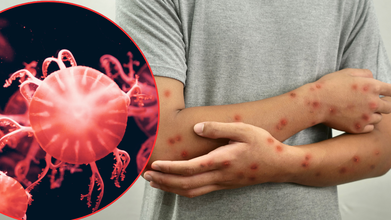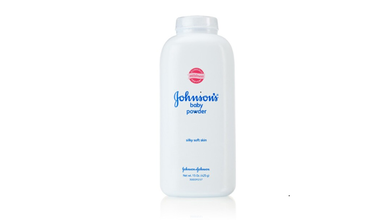- Health Conditions A-Z
- Health & Wellness
- Nutrition
- Fitness
- Health News
- Ayurveda
- Videos
- Medicine A-Z
- Parenting
- Web Stories
Not Wegovy or Mounjaro Or Ozempic: This New Monthly Weight Loss Jab Helped People Drop 20% Body Fat

Credits: Canva (representational)
A new clinical trial has uncovered the breakthrough promise of a new weight loss medication, MariTide, that can be taken only once monthly. Amgen developed the investigational drug, and it has demonstrated remarkable weight loss outcomes up to 20% in individuals with obesity. The Phase 2 trial results, which were released in The New England Journal of Medicine and presented at the American Diabetes Association's annual meeting 2025, may be a turning point in the treatment of obesity and Type 2 diabetes worldwide.
MariTide is a GLP-1 receptor agonist, a type of drug whose behavior is well-known to reduce weight and control Type 2 diabetes. It differentiates from current competitors like Novo Nordisk's Ozempic and Wegovy, and Eli Lilly's Mounjaro and Zepbound, because it has a distinct molecular structure. MariTide contains a monoclonal antibody that means the drug can remain in the body longer. This capability makes the drug possible to give as a once-monthly injection, a major improvement over its weekly-injected counterparts.
Amgen's Phase 2 clinical trial consisted of almost 600 adults, divided into two groups: one with obesity alone and the other with obesity and Type 2 diabetes. Volunteers were assigned to take one of three dose levels of MariTide or a dummy shot. They took monthly injections for 52 weeks, and some in the obesity group started with a low dose that was increased incrementally.
The findings from the Phase 2 clinical trial of MariTide were nothing short of remarkable. Participants who had obesity but did not have diabetes experienced an average weight loss of up to 20% of their body weight after 52 weeks of treatment. Meanwhile, those who were managing both obesity and Type 2 diabetes saw an average weight loss of up to 17%. In sharp contrast, patients in the placebo groups showed only slight decreases in body weight, 2.6% for the group with obesity alone and only 1.4% for the group with obesity and diabetes. These findings highlight the great potential of MariTide as a very effective, once-a-month weight loss treatment.
These findings place MariTide on par with Wegovy and Zepbound in weight loss effects. Although Wegovy studies recorded a 15% decrease after 68 weeks and Zepbound delivered a 22.5% decrease after 72 weeks, MariTide's monthly regimen and similar effectiveness make it a strong contender.
Health Benefits of Using MariTide
MariTide is not only gaining recognition for its effectiveness at weight loss—it's also emerging as a full-range cardiometabolic therapy. Based on trial results, patients on MariTide experienced a dramatic decrease in A1c values, a key measure of long-term blood glucose control. For patients with diabetes, the medication reduced A1c by as much as 2.2 percentage points, outpacing expected decreases of 1.5 to 2.0 points with established GLP-1 therapies such as Ozempic and Mounjaro. But the advantages didn't end there. The research also observed significant reductions in blood pressure, cholesterol, and markers of inflammation, pointing to the potential of MariTide beyond the scale. These results indicate that the drug may provide an all-around solution to obesity as well as other chronic diseases such as cardiovascular disease and type 2 diabetes, making it an attractive option in the changing scenario of metabolic health treatments.
How MariTide Works?
Similar to other GLP-1 receptor agonists, MariTide has a similar action to glucagon-like peptide-1, a hormone that controls blood glucose and hunger. It increases the release of insulin, decreases the release of glucagon, and retards gastric emptying. MariTide differs from other drugs in that it contains a monoclonal antibody that keeps the drug in the body longer. Monthly dosing is made possible by this advance, and treatment compliance may be enhanced by less frequent injections.
Side Effects of 'MariTide' That People Need to Know
Similar to other GLP-1 drugs, side effects in the gastrointestinal tract were most frequently reported during the trial. These consisted of:
- Nausea
- Vomiting
- Diarrhea
- Abdominal discomfort
The side effect profile was comparable to other drugs in the same class according to the research team and largely tolerable overall. Large-scale Phase 3 trials will be important to best evaluate long-term safety and infrequent adverse events, though.
MariTide vs Wegovy, Mounjaro, and Others
If approved, MariTide would represent Amgen's foray into a weight loss market led by Novo Nordisk and Eli Lilly. Wegovy and Mounjaro have experienced explosive growth as a result of their robust efficacy results. Yet, MariTide's monthly dosing regimen and dual utility in diabetes care and weight loss may resonate with a vast patient population.
The comparisons between MariTide and existing GLP-1 drugs have not yet been conducted. Still, the early data suggests that Amgen’s candidate could stand toe-to-toe with the industry giants.
What’s Next for MariTide?
Amgen said it plans a Phase 3 clinical trial to further study MariTide for 72 weeks. If all goes well, the results of this research may lead to FDA approval and future distribution worldwide. Most analysts expect it will be at least a couple of years before MariTide is widely available, though.
With rates of obesity on the rise globally and related health issues costing billions each year, effective, affordable, and sustainable weight-loss solutions have never been more vital. MariTide's encouraging results provide a timely new alternative to an expanding stockpile of obesity-fighting weapons.
First Locally Acquired Clade 1 Mpox Case Detected California, Symptoms You Should Look Out For

(Credit-Canva)
The Long Beach Department of Health and Human Services has confirmed its first case of locally acquired Clade-1 Monkeypox strain. In a recent press release, the authorities informed the citizens that the person who was diagnosed had no recent travel history, which means the virus was contracted locally.
While the risk for the public remains low, the health department warns people to stay safe. Since it is a contagious disease, the health investigation is still ongoing, as the public officers comb through the person’s history. However, currently there are no other cases of the clade 1 mpox. Mayor Rex Richardson said, “While the overall risk of mpox clade I exposure to the public remains low, we are taking this very seriously and ensuring our community and health care partners remain vigilant so we can prevent any more cases.”
What Is Mpox?
According to the World Health Organization, Mpox (previously called monkeypox) is a sickness caused by a virus. Think of it as being like different types of flu—there are a few versions of the mpox virus, called clades.
The global outbreak that happened in 2022–2023 was caused by one of these versions, specifically Clade IIb. The virus spreads through close contact with an infected person's sores or body fluids, with contaminated items like bedding, or with infected animals. The virus can also be passed from a pregnant person to their baby.
Most mpox treatment involves supportive care—doctors help manage symptoms like pain and fever while the body recovers. This includes keeping the patient well-nourished and hydrated, caring for the rash, and addressing any secondary infections. Fortunately, vaccines are available for mpox.
How is Clade 1 Different From Clade 2?
This new case involves Clade 1 mpox, which is historically associated with more severe illness and is typically found in Central and East Africa.
In contrast, the large 2022-2023 outbreak in the U.S. and globally was caused by Clade 2, which usually results in milder illness. Mpox, regardless of the clade, spreads through direct contact with sores, body fluids, intimate contact, or contaminated items. Symptoms can include a rash or sores, fever, chills, sore throat, swollen lymph nodes, and body aches.
What Are The Health Risks of Mpox?
Long Beach health officials are currently investigating the patient's source of exposure and conducting contact tracing, though no other cases have been identified so far.
Long Beach Mayor Rex Richardson emphasized that while the overall risk to the public remains low, the city is taking the situation seriously. He stressed the importance of continued surveillance, early response, and vaccination.
A Long Beach public health physician, Dr. Cliff Okada, advised: "Anyone with an unexplained rash or lesions should seek care promptly. Speak openly with intimate partners and your healthcare provider. Early action protects you and others."
Who Is At Risk For Mpox Clade 1?
The Centers for Disease Control and Prevention (CDC) continues to recommend the Jynneos vaccine for people at high risk of exposure. This includes gay, bisexual, and other men who are intimately involved with other men, transgender and non-binary people, those with weakened immune systems (such as people with HIV), individuals exposed to an infected person, those with occupational exposure, and people traveling to areas with ongoing outbreaks.
Most mpox patients recover on their own within 2 to 4 weeks. A booster shot is not currently recommended for those who have completed the two-dose vaccine series.
Liam Payne’s Girlfriend Kate Cassidy Opens Up About Her Depression Following Singer’s Death

Credits: Canva
Liam Payne's death marks a whole year, and his girlfriend Kate Cassidy reflected on his death anniversary. She also opened up about her depression after his death. Cassidy lost her boyfriend, former One Direction member in 2024, and as she said, her world collapsed.
The 26-year-old social media star has now opened up about her painful journey through grief, depression, and eventually healing.
In an interview to Page Six, she said, "I was always just kind of doing nothing and just dealing with that grief and pain. I was admittedly mired in depression and just not wanting to really live my life.”
For weeks, Cassidy found herself unable to function, trapped between disbelief and heartbreak. But around two months later, something shifted.
“I finally realized, ‘OK, like I need to live my life. I need to get up, get out of bed,’” she recalled.
The Way To Healing
However, she was determined to pull herself out of darkness and so she began to rebuild her days, one small habit at a time. She started to set her alarm earlier each morning, forcing herself to wake up and move. "I began working out, eating clean," she said. "I like to always be up early, have a workout class planned, go for a nice walk, eat cleaner. For me, being active always keep my mind so much cleaner and healthier," she explained.
Gradually, she also learned to navigate her life without Payne, and kept herself busy. She said that she tried to be as busy as she can to help her headspace.
Also Read: Liam Payne Investigation: How Pink Cocaine Affects You?
Acknowledging The Hard Truth
Payne's death was a devastating news for her as well as for her fans. The 31-year-old singer died in October 2024, after falling from a third-storey balcony at the CasaSur Palermo Hotel in Buenos Aries, Argentina.
An autopsy report later revealed that Payne had drugs in his system and the authorities determined that he fell to his death while trying to escape the hotel room after he was locked in.
Cassidy had joined Payne on the trip, but returned home two days before his death. Following his death, she revealed that they had talked about spending their lives together. "We had so many plans. He lit up my room. He was just so sweet, so funny. I've never met anybody like him and I'm sure I probably won't ever meet anybody like him in my life."
Almost a year later, Cassidy is filled with both sorrow and gratitude. "In a way, I am glad that he is going to be that one person. He was the best person I ever met."
Cassidy said that through grief she is learning to embrace life again.
What Depression Feels Like After You Lose Someone
Cassidy opened up that right after losing Payne, she felt like she could not live anymore. While grief and loss is a natural emotional response to the loss of someone close, often, one slips through depression, if they are not able to cope with the loss.
Depression is a mood disorder and it causes a persistent feeling of sadness, and further affects your emotional and physical well-being.
NHS UK notes that people who deal with grief and loss feel shock and first and numb after and then they go into the phase of overwhelming sadness, tiredness, exhaustion, and sometimes anger.
However, there are things one can do, notes NHS UK, which includes talking to a friend, a mental health expert, go for peer support, and try to bring in simple lifestyle changes to help you feel more in control and able to cope.
Johnson & Johnson Faces Major UK Lawsuit Over Alleged Cancer-Causing Contents in Baby Powder

Credits: J&J Website
Johnson Baby Talcum Powder: A major lawsuit has been filed in the UK against the popular pharmaceutical giant Johnson & Johnson (J&J). The company is accused of knowingly selling baby powder that contains asbestos, a substance linked to deadly cancers.
The legal claim is being led by KP law, and involved around 3,000 people. The company is alleged to be aware for decades that its talc-based baby powder contained cancer-causing fibers.
Decades of Warnings Ignored
BBC reports that as per the court papers, J&K knew about this in as early as in the 1960s. The company was aware that the talc contained fibrous forms of tremolite and actinolite, both of which are classified as asbestos when in fibrous form. However, the company failed to warn its consumers and promoted the product as 'safe' and 'pure'.
The documents accessed by the BBC from 1973 notes that the company acknowledged, "our baby powder contains talc fragments classifiable as fibre. Occasionally sub-trace quantities of tremolite or actinolite are identifiable".
However, no public memo was issued, instead the company's executives discussed it to keep the findings confidential. One memo also reported, "We may wish to keep the whole thing confidential rather than allow it to be published in patent form and thus let the whole world know.”
However, J&J currently is denying all such claims and said that the baby powder "was compliant with all regulatory standards, did not contain asbestos, and does not cause cancer.” The company’s UK sales of talc-based powder ended in 2023.
Who Is Safe, Who Is Not?
The lawsuit against J&J alleges that instead of warning the customers, the company continued to maintain the product's wholesome image of 'purity'. During the 1970s and 80s advertisements, the powder was shown as gentle and safe for newborns. By 1990s and early 2000s, the company shifted its marketing focus toward African American women.
In an email from 2008, one employee wrote: "The reality that talc is unsafe for use on/around babies is disturbing. I don’t think we can continue to call it baby powder and keep it in the baby aisle.”
Kenvue, J&J’s consumer health spinoff, said the email was taken out of context, claiming it referred to the known risk of asphyxiation, not cancer, reported the BBC.
Pressure On Regulators
Several documents cited in the legal claim that the company also worked to influence the US regulators. From the early 1970s, the company pushed the Food and Drug Administration (FDA) to accept testing standards that were less sensitive. This meant that smaller amounts of asbestos could go undetected.
The company proposed tolerance levels of asbestos up to 1%, in talc, and said that sensitive tests were unnecessary. This allowed the company to continue with their claim that the product is 'asbestos-free'. All these claims have been dismissed by Kenvue, saying that the document in reference is a 'hypothetical calculation' requested by the FDA.
What Is The Human Cost?
Many of the claimants have either developed or lost loved ones to ovarian cancer, mesothelioma, or other asbestos-related illnesses.
One such claimant, Siobhan Ryan, a 63-year-old from Somerset, recalls using J&J baby powder on her children, just as her mother had used it on her. “It smelt nice and was soft and lovely. I thought I was doing my best for them,” she told the BBC.
Years later, she was diagnosed with stage 4 ovarian cancer. After rounds of chemotherapy, major surgery, and a near-fatal case of sepsis, Siobhan is still undergoing treatment. “They knew it was contaminated and still they sold it to new mums and their babies,” she said.
The consequences are beyond the UK. The same is on going in the United States, where multiple lawsuits against the company have already been filed. Earlier this month, a Connecticut court ordered J&J and its successors to pay $25 million to a man diagnosed with terminal peritoneal mesothelioma after lifelong use of the baby powder. The jury found J&J negligent, noting that safer alternatives like cornstarch were available but ignored.
During that trial, a former J&J toxicology director admitted he had made public safety assurances without reviewing any test data and failed to report results that showed asbestos in the product.
What Is The Company's Take?
While the company said that it "sympathizes deeply with people living with cancer", it maintained its stance that the powder is safe to use and that it "did not contain asbestos and does not cause cancer."
However, lawyers in the UK say damages could reach hundreds of millions of pounds, making this potentially the largest product liability case in British history.
© 2024 Bennett, Coleman & Company Limited

